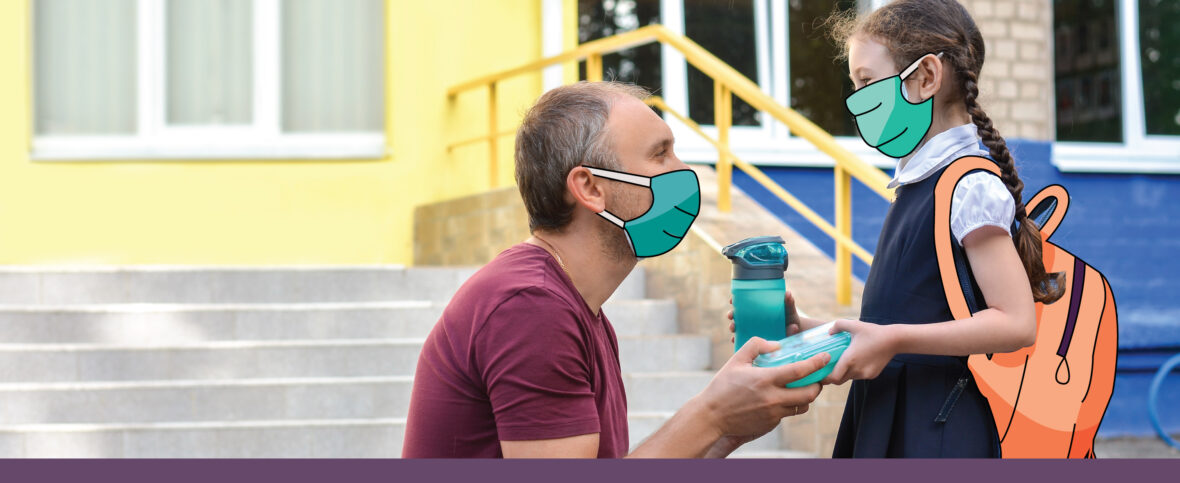See all > Covid-19

September 1, 2021 • read
COVID-19 safety tips as you plan for back-to-school
As summer winds down and the first day of school inches closer, parents and students are grappling with a huge question — what will the new school year actually look like? COVID-19 has upended daily life, especially in schools. As the new and more contagious delta variant ushers in a fourth wave in Canada, it looks like COVID-19 won’t be fading away anytime soon. Here’s how to make back-to-school as safe as possible this year.
1. Stock up on masks
As the fourth wave of COVID-19 infections gets underway, Canada is a patchwork of public health regulations. Different jurisdictions are calling for different approaches, and they’re not always based on the number of community infections. Some provinces aren’t mandating masking in schools, leaving regional school boards to implement regulations to protect staff and students. Regardless of official rules, however, if community spread is happening where you live, health experts recommend wearing non-medical masks in schools. Children under 12 can’t get vaccinated yet, but they can still get and transmit COVID-19. If your child is attending school in person, wearing a mask indoors is one of the best ways to protect themselves.
2. Discuss behavioural expectations ahead of time
Most kids know a fair amount about COVID-19 by now. Recent changes in public health measures, however, may be causing some confusion. Sit down with your child before their first day to discuss what your behavioural expectations around COVID-19 at school are. Let them know that they can’t share food or drinks with friends. You can also practice proper hand sanitation with them at home, and discuss when they should be using hand sanitizer or washing their hands during the day. If they haven’t done it already, practice wearing a mask with your child for increasing lengths of time in preparation for doing it all day at school. This is also a great way to make sure that they can put on and take off their own mask. Your child’s not going to do everything perfectly when you’re not there, but practice will help.
3. Get everyone vaccinated — if you can
While vaccines are safe for kids 12 and up, they haven’t been rolled out for the younger set just yet. This leaves millions of children vulnerable to contracting COVID-19. While most kids don’t develop serious illness from COVID-19, a small percentage do. Children can also get very sick weeks after they have COVID-19 with a serious illness called multisystem inflammatory syndrome (MIS-C). Presently, the best way to protect your child from developing MIS-C or a severe case of COVID-19 is by keeping them from contracting COVID-19 in the first place.
Moderna anticipates they’ll be ready for regulatory approval of the COVID-19 vaccine in six to 12-year-olds by this fall, and for children six months and up by the end of the year. Until then, keeping kids safe means it’s more important than ever that those who can get their jabs, do. By vaccinating as many people as possible, Canadians can help to slow the progression of COVID-19, making it less likely that the under 12 set will come into contact with a case of it. If you or someone in your household who is 12 years of age or older haven’t been fully vaccinated yet, you can easily book an appointment.
4. Keep it consistent at home
Kids are smart, and they notice your behaviour just as much as your words. If you’re telling them they need to wear a mask, keep their distance, and wash their hands regularly at school, it’s best to model the same behaviour yourself. Keep social occasions small and outdoors, and wear a mask in indoor public settings like on public transit or in the grocery store. For your kids, indoor playdates and sleepover parties should take a back seat to park hangouts, for now. If your child sees you consistently modelling safe behaviour, they’re more likely to do it when you’re not around too.
As you plan for back-to-school, COVID-19 has shifted the focus away from the usual preparations to making sure your child stays safe. But no matter what you do at home, certain safety measures are up to school boards to implement — things like upgrading ventilation in classrooms, cohorting, and spending time outdoors. Reach out to your child’s school and ask what safety measures they’ve implemented if you’re not sure. By continuing to take precautions at home and pushing for appropriate classroom interventions, you can help to make back-to-school safer this year.
The information presented here is for educational purposes and is not meant to replace the advice from your medical professional.
When using virtual care, all medical treatment is at the sole discretion of the provider. Virtual care is not meant for medical emergencies, and your provider will determine if your case is appropriate for virtual care. If you are experiencing an emergency like chest pain or difficulties breathing, for example, please call 911 or go to your nearest emergency room.
Trusted by millions of Canadians
Get started now

We're trusted by millions of Canadians
Join millions of Canadian families who enjoy 24/7 access to medical care within minutes.
Get started now4.6 score
5K+ Trustpilot reviews
Do you need medical care today?
Trusted, experienced doctors and nurse practitioners are ready to see you.
